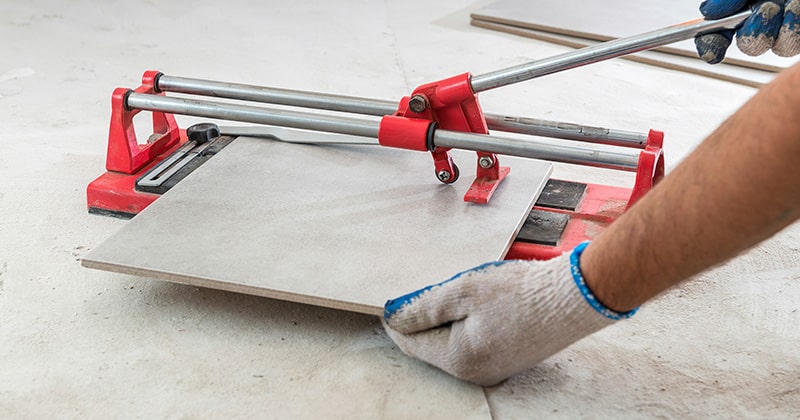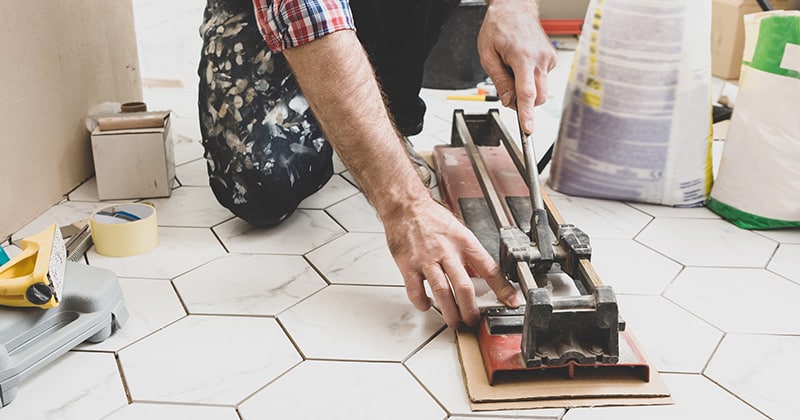The 7 Best Tile Cutters for Flooring Contractors
Laying tiles without the appropriate tools can cost you time and money. Discover how to cut tiles precisely, smoothly, and efficiently with the best tile cutters for flooring installation.

Staff Contributor
Laying tiles is easy. But doing it perfectly takes skill, experience, and proper tools.
Cutting tiles is one of the most challenging tasks in floor tiling. And it’s not like you can avoid doing it either. What are the odds of finding a floor space that perfectly fits full-sized tiles from end to end? Plus, you may have to cut your way around a toilet flange, door frame, pillar, or curved wall.
Now, imagine having to cut curves, straights, angles, and circular holes on dozens of 12 × 24-inch rectified porcelain tiles. Your choice of cutting tool can really make a difference.
Using a suitable tile cutter not only ensures clean, precise cuts but also saves you a ton of trouble and time.
So, what is the best tile-cutting tool for flooring contractors?
Well, a single tool just won’t do. You need a variety of tools to handle all the different types of tiles and cuts.
This article is a comprehensive guide to the best tile cutters for flooring installation. It covers the following talking points:
- The importance of having a suitable tile cutter on floor installation jobs
- The different types of tile cutters available today
- Examples of some of the best tile cutters for contractors
- Must-have tools for flooring contractors
- Essential tips for selecting the best tile cutter
Let’s dive into the world of tile cutters.
What’s the Impact of a Quality Tile Cutter on Flooring Installation?
Use the right tool for the right job. That’s contracting 101.
Tiling is just one of those jobs that becomes incredibly hard when you don’t have the right tools. Cutting tiles is especially tool-dependent. You can’t use brute force to cut a tile, and there’s usually no way to get around doing it.
Here are five reasons why an appropriate tile cutter is essential in flooring jobs:
Cut Clean and Smooth Edges
Tiling is precision artwork. Flooring precision means the substrate must be level, the tiles must be equally spaced, and the tile edges must be well-defined. The tiling pattern and layout also matter a great deal.
Precision cuts ensure seamless and natural transitions between tiles and other elements. Clean cuts also maintain uniformity in the tile’s pattern, boundaries, and overall layout.
To make precise, clean, and smooth cuts, you need the right tile cutter.
Glass, marble, mosaic, and encaustic floor tiles are especially unforgiving when poorly cut. Rough, jagged, or crooked edges affect how the tile pieces fit together. A poor fit will spoil the pattern and how light reflects off the finished surface.
Save Time Cutting Tiles
Cutting tiles is a time-consuming process, especially when doing it with the wrong tool.
As a flooring contractor, you probably cut a lot of tiles. Saving even a minute on every cut can amount to hours of saved labor.
Say, for instance, a job requires 100 curved porcelain tiles. Porcelain is notoriously hard and brittle. So, making each cut with a manual handheld tool takes 10 minutes. By that logic, tile cutting alone is a 15-hour job.
Now, imagine you had a mechanized tool designed for cutting porcelain tiles. Each cut would take well under three minutes, saving you over 10 hours of tedious, painstaking work.
Remember, saving time saves money.
Minimize Safety Risks
Jagged edges on flooring tiles are a safety hazard. If cut poorly, porcelain, ceramic, and marble tiles form particularly sharp, jagged edges. Those edges can puncture through the skin and even some PPE gear and cause serious injuries.
The glass-like coating on glazed tiles is another safety hazard. The glaze can sheer and fly off in all directions when using improper or low-quality tile cutters. The stray glaze can get into someone’s eye or ear, and large pieces can even pierce the skin.
Using the right tile cutter reduces the risk of dangerous edges and projectiles.
Reduce Material Waste
Using the wrong tile cutter will inevitably damage tiles. A bad tool will not cut with the much-needed care and precision.
Losing tiles to poor cutting can be expensive, especially when working with high-quality tiles. A single premium marble or porcelain tile costs upward of $20. That’s not a risk you can afford to take, as you might end up losing money on a flooring job.
Increase Job Security
There’s an ideal cutting tool for each type of floor tile. For instance, you can’t use the same tool to cut decorative glass tiles and heavy-duty granite tiles.
The physical properties of the tile determine which tile cutter may be used. The tile’s hardness, brittleness, density, thickness, and dimensions must be considered.
Additionally, you’ll need different tools to make various kinds of cuts. For example, some tile cutters only do straight cuts, while others are specialized in boring. Plus, you have to get creative with various tools to make complex cuts such as angles, holes, and curves.
Your assortment of tile cutters can dictate what sort of flooring jobs you can take on. If you can cut any tile into any shape or size, you can handle any floor installation. Having all the right tile cutters expands your flooring portfolio, earning capacity, and job security.

What Are the Different Tile Cutter Types?
As a flooring contractor, you should be aware of all the different types of tile cutters. You may not need or use all of them, but it’s good to know what’s out there.
When choosing a tile cutter, you have these four main options:
Handheld Manual Tile Cutters
Handheld manual tile cutters are some of the most basic tile-cutting tools. They use a cutting technique known as score-and-snap, which works on a variety of tiles, including ceramic and porcelain.
The tool looks like a pair of pliers, except the jaws are fitted with a scoring wheel and a breaking mechanism.
It works in two steps. First, use the wheel to score the tile along the cut line. You do so by pressing the wheel hard onto the tile and rolling it from one end to the other. This creates a scribe line on the tile’s surface.
Second, open the tool’s jaws and clamp them against the tile with the breaking mechanism pushing on either side of the scribe line. Then, squeeze the levers together to snap the tile.
This type of tile cutter is only good for cutting straight lines. Even then, it’s difficult to score the tile along a perfectly straight line with the tool. Plus, it only works on small, thin, and relatively soft tiles.
That said, it’s a handy addition to a contractor’s toolkit. It’s helpful in making quick, small tile cuts on the go.
Tabletop Manual Tile Cutters
Tabletop tile cutters are a big step up from their handheld counterparts.
They also cut tiles using the score-and-snap method, but they are much easier to use and more precise. Plus, they can cut much bigger, harder, and thicker tiles, including 12″ × 24″ × 0.5″ porcelain tiles.
The tool has a sturdy base on which is a flat platform (bed). Above the bed is a single or double rail system running the entire length. And the scoring and breaking mechanisms run freely along the rails with the push or pull of a hand-operated lever.
The tile goes on the bed right underneath the scoring tool. You pull or push the lever while pressing down on the tile to mark a scribe line and then push it down to snap the tile along the score line.
This system gives you more leverage and precision when scoring and snapping a tile. It also produces clean cuts when used properly. But only straight cuts, though.
Handheld Electric Tile Cutters
A handheld electric tile cutter is essentially a portable circular saw, much like those used to cut wood. Instead of a sawing blade, the tool is fitted with a diamond blade that’s ideal for cutting tiles.
To cut a tile, you simply place it on a workbench. Holding the saw with both hands, align the blade with where you want to cut and saw away. It’s a pretty straightforward cutting procedure.
Electric tile cutters come in two main variations: wet saw and dry saw. A wet saw cutter runs water over the blade as it cuts. The water lubricates the blade as it grinds against the tile. It also absorbs and takes away debris, so there’s no dust.
A dry saw, as the name implies, has no lubrication.
When given a choice, always go for the wet saw. The blade lasts longer, and you won’t have to worry about dust.
The only downside of a portable wet saw tile cutter is water management. You have to refill the water reservoir and consider where the wastewater goes, although most high-end wet saws have an automatic water circulation system.
Tabletop Electric Tile Cutters
This type of tile cutter also features a circular saw. But unlike the portable kind, the saw and motor assembly reside on a stationary platform.
It has a movable table on which you place your tile. In most versions, you push the tile toward the saw when cutting; in others, the saw moves while the tile remains stationary. Either way, these are much safer and easier to use than handheld saws.
Again, you have a choice of wet or dry saw. And even with mounted saws, wet cutting is more advantageous. Moreover, some wet tile saws reuse their wastewater, so you don’t have to catch the wastewater or refill the water reservoir.
Both handheld and tabletop electric tile cutters can cut through any tile. It all comes down to the sharpness of the blade and the motor’s toque. These can also cut angled pieces and even shallow curves. Plus, you have more control over precision.

The 7 Best Tile Cutters for Flooring Contractors
When shopping for tile cutters, you’ll quickly realize you’re spoilt for choice. There are dozens, if not hundreds, of brands selling all kinds of tile cutters.
However, not all tile cutters are made equal. There are so many factors to consider when buying a tile cutter that it can get overwhelming.
To get you started, we’ve compiled this list of the top 10 best tile cutters for flooring installation, highlighting their key features, pros, and cons:
The Best Manual Tile Cutters
Goldblatt G02010 Hand Tile Cutter
Cutting tiles doesn’t get simpler than this. The Goldblatt G02010 is a basic handheld score-and-snap tool. It features a replaceable high-quality carbide scoring wheel and a sturdy plastic breaker bar. The assembly can score and snap tiles up to ¼ inches thick. The levers are a pair of ergonomic anti-slip soft-grip handles.
Pros
- The snapping tool costs only $19.95.
- It comes with the Goldblatt Guarantee.
Cons
- The plastic breaker bar is irreplaceable.
- The tool only works with small floor tiles.
VEVOR Manual Tile Cutter
VEVOR’s manual tile cutter is a robust tool with a stainless-steel double-rail construction. The base is made of heavy-duty aluminum resting on non-slip rubber. A pair of extension arms provide support for large tiles and extra stability.
The tool has three useful measuring features: an inbuilt precision ruler, an angle adjuster, and an accurate laser positioning system.
The business end features a tungsten carbide scoring wheel. And to complete the job, a steel breaking bar lined with tough rubber snaps the tile. It cuts tiles measuring up to 48 inches long and 0.6 inches thick.
Pros
- The measuring and precision assists make for accurate cuts.
- The 48-inch cutting length accommodates a wide range of flooring tiles and cutting orientations.
Cons
- At $117.99, the price is pretty steep for a manual tile cutter.
- Given the long frame, breaking porcelain tiles thicker than 0.4 inches might stress the rails.
The Best Electric Tile Cutters
RYOBI 4″ Hand-Held AC Tile Saw
RYOBI’s portable wet tile cutter features a powerful 12-amp AC motor spinning a 4-inch diamond blade at 13,700 rpm. With such power, you can cut any tile to a 1-5/32-inch depth.
For the wet part, the saw has a 12-foot water supply hose with an adjustable flow regulator and faucet adapter. And the base plate tilts up to 45 degrees, allowing for clean beveled cuts.
Pros
- The saw is backed by RYOBI’s 3-year limited warranty.
- The lightweight construction makes the saw easy and comfortable to use.
Cons
- The power cord and water hose can get in the way when cutting.
- When running wet, the water source must have enough pressure to supply the saw with a constant flow of water.
Makita 12V max CXT® Lithium-Ion Cordless Tile Saw Kit
If you’re looking for a completely portable electric tile cutter, this battery-powered wet saw from Makita is the tool for you. It’s fitted with Makita’s 2.0Ah 12V max CXT® lithium-ion battery, which eliminates the power cord.
A 12V DC motor powers a 3-3/8-inch diamond blade that cuts glass and tiles at up to a 45-degree bevel angle. Just above the motor assembly is a 16.9-ounce water supply tank for wetting the blade and the cutting surface.
Pros
- At only 4.2 pounds, the Makita saw is lightweight and compact.
- The cordless design means the saw can be used anywhere.
Cons
- The small blade cuts to a maximum depth of only 1 inch at 90 degrees and 5/8 inches at 45 degrees.
- The saw’s low-power motor, limited battery pack, and small blade are designed for cutting small tiles and not for bulk use.
DOVAMAN Mini Circular Saw
The DOVAMAN circular saw is a compact, multipurpose dry saw that’s convenient and easy to use. It has a 5.8-amp motor spinning a 4¾-inch blade at 3,500 rpm. The blade cuts to a depth of 1-11/16 inches and bevels up to 45 degrees.
The saw is loaded with useful ergonomic, convenience, and safety features. It has a detachable metal auxiliary handle, edge and laser guides, and a fault-protected trigger mechanism.
Pros
- The saw has a compact, lightweight construction for easy use and maneuverability.
- For $89.97, you get the saw plus six blades: two for cutting wood, two for metal, and another two for tiles.
Cons
- A 4¾-inch blade is too small to cut through thick tile slabs, especially at steep angles.
- While lightweight, 8.8 pounds may be too heavy to hold in one hand during prolonged use.
VEVOR Wet Tile Saw
The VEVOR wet tile cutter is as basic as a tabletop wet saw gets. And it’s good value for money too. It’s a wet saw under $100 that cuts all types of tiles to a maximum depth of 1.25 inches.
The saw’s heart is a 3,500-rpm induction motor powering a 7-inch 65Mn diamond blade. Sitting on top of the drivetrain is a corrosion-, scratch-, and rust-proof galvanized work surface with a 0-45 degrees miter angle.
The bottom half of the saw is submerged in a removable water reservoir. This water lubricates and cools the saw and catches debris and dust.
Pros
- VEVOR’s wet saw is good value for money at only $72.99 (even lower with a registration discount).
- The circuitry includes a reset safety switch to prevent injuries and damage after power interruptions.
Cons
- The blade spinning in the water reservoir creates a messy spray.
- You may need a bigger, more powerful saw for larger, harder, and thicker tiles.
RIDGID 15 Amp 10 in. Wet Tile Saw
RIDGID’s 15-amp 10-inch wet tile saw is the ultimate tile cutter for flooring contractors. It’s a beast of a machine. With its powerful motor and large blade, the saw makes easy work of any tile, including thick and hardened porcelain, granite, and natural stone tiles.
The cutting assembly and workbench sit on a removable, adjustable, foldable, and movable industrial-grade stand. A robust water circulation system designed to maximize cooling and lubrication while minimizing splash and spray wets the spinning blade.
Pros
- The saw is best in class for bulk tile-cutting jobs.
- After signing the Lifetime Service Agreement, you get free parts and free service for life.
Cons
- Retailing at $814.00, it might be prohibitively expensive (and frankly unnecessary) for small flooring contractors.
- Weighing just shy of 100 pounds, the saw is heavy and bulky.
Additional Cutting Tools
In addition to specialized tile cutters, here are three tools that might come in handy when laying tiles:
Tile Nipper
A tile nipper, sometimes called a tile plier, is a simple handheld tool for cutting soft, thin tiles. It looks like a pair of tile snappers, except its jaws end in two rugged cutting teeth.
It works by chipping away at the tile. It’s great for cutting small curves or other irregular shapes that would be impossible when using a saw or snap cutters.
However, the tile nipper is a terrible tool for making straight cuts. Cutting with a nipper is painstaking work that requires patience and dexterity—not ideal for bulk tile cutting.
Hole Saw
A hole saw is a drill attachment for making round holes. These are typically used for boring wood and metal plates, but the right saw can bore tiles too. And they come in a range of diameters, from fractions of an inch to several inches.
Using a hole saw can save you a lot of time and headaches when cutting circular holes in tiles.
Angle Grinder
An angle grinder is one of the most versatile power tools for contractors. When fitted with a diamond blade, it becomes a handheld electric tile saw.
It may not be as precise as a specialized tile saw, but in the right hands, it can cut through just about any tile. Plus, angle grinders are more maneuverable and flexible since they do not have base plates. With a steady hand, you can easily cut straights, curves, angles, and even circles in any orientation.
Top Takeaway Tips for Selecting the Best Tile Cutter
-
Without a suitable tile cutter, you risk losing time, wasting flooring material, incurring injuries, and compromising the quality of work when laying tiles.
-
Understand the characteristics of the tiles you’re working with—size, dimensions, hardness, etc.
-
Shop around for the ideal tile cutter while considering ease of use, convenience, cost, and effectiveness.
-
You can always hire some of the more expensive tile cutters for one-off jobs instead of buying.
-
Buy a tile cutter based on the level of use you hope to get out of it.
-
Fitting a diamond blade on a conventional angle grinder instantly transforms it into a versatile tile cutter.
-
A single tool will not meet all your tile-cutting demands; you’ll need a tool kit with several different types of tile cutters.
Alison began her career as a storyteller crafting a variety of engaging content. She has experience in creative writing, marketing, social media, and education. When she's not writing, she's spending time with her family and dog.

Business Solutions For Field Service Pros
EverPro offers specialized solutions designed for home and field service professionals. We’ve got the business tools to help you get the job done.



